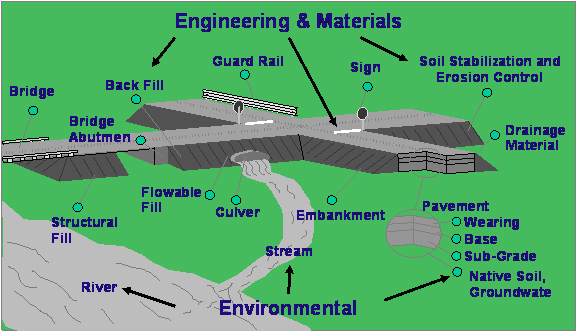Glossary of Terms
Terms as they relate to the User Guidelines for By-Product Materials in Pavement Construction
Figure 1. Diagram of Roadway
Aggregate: a hard, inert granular material such as sand, gravel, shell, slag, or crushed stone.
Asphalt: a dark brown to black cementitious material in which the predominating constituents are bitumens that occur in nature or are obtained by petroleum processing.
Asphalt Binder: a dark brown to black cementitious material, in which the predominant constituents (+99%) are bitumens which occur in nature or are obtained as residue in petroleum manufacturing, and are used as binder in asphalt-aggregate mixes.
Asphalt Concrete: a high quality mixture of asphalt binder and carefully graded coarse and fine aggregates.
Asphalt Pavement: pavement consisting of asphalt concrete layer(s) on supporting courses such as concrete base, asphalt treated base, cement treated base, granular base, and/or granular subbase placed over the subgrade.
Asphalt Rejuvenator: a liquid petroleum product, usually containing matenes, added to asphalt paving material to restore proper viscosity, plasticity and flexibility to the asphalt.
Backfill: material used to refill an excavated area or to backfill or refill (an excavated area) with such material.
Base: a layer of specified or selected material of planned thickness constructed on the subgrade or subbase for the purpose of serving one or more functions such as distributing load, providing drainage, minimizing frost action, etc.
Binder: an adhesive composition of asphalt binder, which is primarily responsible for binding aggregate particles together.
Bitumens: a class of black or dark-colored (solid, semi-solid or viscous) cementitious substances, natural or manufactured, composed principally of high molecular weight hydrocarbons, of which asphalts, tars and pitches are typical.
Bituminous: containing or treated with bitumen.
Byproduct: a material produced in the making of something else.
Clinker: the incombustible residue, fused into an irregular lump, that remains after the combustion of coal.
Coarse Aggregate: that portion of aggregate retained on the No. 4 (4.75mm) sieve.
Combustion chamber:the container used in the combustion of materials.
Corrosivity: ability to dissolve or breakdown particular substances, particularly metals.
Cure: process by which a liquid substance becomes hard.
Curing age:the amount of time necessary for a pavement or concrete to cure.
Embankment: a mound of earth built to support a roadway (see Figure 1).
Fine Aggregate: aggregate passing the No. 4 (4.75mm) sieve and predominantly retained on the No. 200 sieve (0.075mm) sieve.
Fines: proportion of a soil or clay and silt particles in an aggregate. Finer than the No. 200 (0.075mm) sieve.
Frost heave: the rise in a pavement surface caused by the freezing of pore water and/or the creation of ice lenses in the underlying layers.
Hopper: A usually funnel-shaped container in which materials, such as grain or coal, are stored in readiness for dispensation.
Hydraulic conductivity: The extent to which a given substance allows water to flow through it, determined by such factors as sorting and grain size and shape.
Internal friction angle: the slope angle where a balance is reached between shear stresses and strengths within a soil material in isolation. It is the maximum slope angle at which loose material can be piled.
Lignite: A soft, brownish-black coal in which the alteration of vegetable matter has proceeded further than in peat but not as far as in bituminous coal, also called brown coal.
Material: a tangible substance that goes into the makeup of a physical object.
Permeability: the rate of flow of a liquid or gas through a porous material.
pH: a measure of the acidity or alkalinity of a solution, numerically equal to 7 for neutral solutions, increasing with increasing alkalinity and decreasing with increasing acidity. The pH scale commonly in use ranges from 0 to 14.
Porosity: the ratio of the volume of all the pores in a material to the volume of the whole.
Portland Cement: a hydraulic cement comprised of very fine grains produced by pulverizing clinkers consisting essentially of hydraulic calcium silicates and calcium sulfate.
Portland Cement Concrete (PCC): the product of mixing Portland cement, mineral aggregates, water, and in some cases additives such as an air entering agent which result in a hardened structural material after hydration.
Products: materials produced from a process (e.g., manufacturing).
Prompt Roofing Shingle Scrap (Roofing Shingle Tabs): asphalt roofing shingles that are generated when new asphalt shingles are trimmed during production to the required physical dimensions or from “out-of-spec” shingles.
Pozzolanic: a siliceous volcanic ash used to produce hydraulic cement.
Reclaimed Asphalt Pavement (RAP): asphalt pavement or pacing mixture removed from its original location for used in another application.
Recycle: to use a waste or by-product as an input material in the construction or manufacture of another product (replacing virgin material).
Reduce: to lower in amount (in this case, amount produced).
Resistivity: an intrinsic property of a material that is measured as its resistance to current per unit length for a uniform cross section.
Reuse: to use again as-is or after processing.
Use: to utilize in an application.
Secant modulus: the slope of a line drawn from the origin to any point on a nonlinear stress-strain curve.
Strength: the ability of a material to resist deformation when a stress is applied to it.
Stiffness: the physical property of being inflexible and hard to bend.
Subbase: the layer of select compacted granular material placed on the subgrade which is overlain by the base of a flexible pavement structure or the Portland cement concrete slab of a rigid pavement structure.
Subgrade: the soil prepared and compacted to support a pavement structure.
Sluiceway: an artificial channel, especially one for carrying off excess water.
Subbituminous: coal of lower rank than bituminous coal but higher than lignite.
Tangent modulus: the instantaneous slope at any point on the stress-strain curve.
Tear-off Roofing Shingles: asphalt roofing shingles that are generated during the demolition or replacement of existing roofs.
Unconfined compression strength: the load per unit area at which soil will fail in compression.
Virgin Aggregate: aggregate that has been mined and not used in any prior applications.


